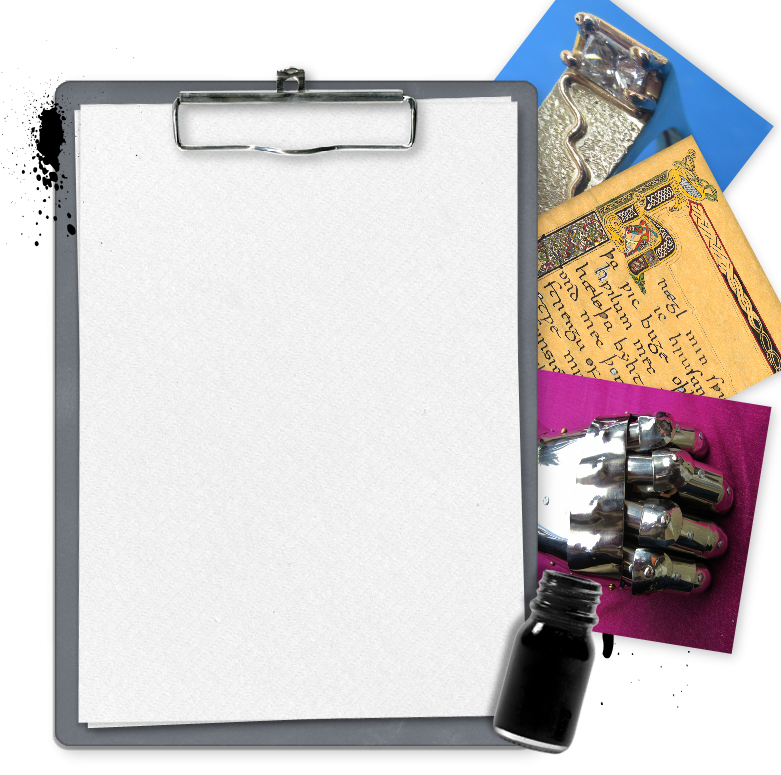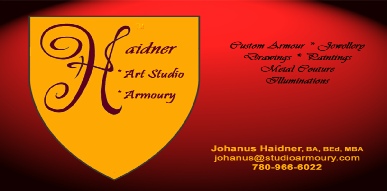

Armour
How much does a suit of armour cost?
This is difficult to answer and there really is no single price for a suit of armour. Generally speaking a suit of armour can cost as little as $5000 or much, much more. If I were to make a proper suit of Henry II armour (complete with gold and silver and all the fine artwork repoussé involved), I am sure it would cost in the range of $250,000, possibly more. And it would take years of my dedicated time.
Most suits are usually in the $6500 to $8000 range, assuming they are made of mild steel. This cost is largely because of the detail that makes this suit historically accurate. Stainless steel will cost considerably more, as it is extremely difficult to work compared to mild steel.
What is the wait time on an order?
This can vary considerably, depending on what the order is. A set of 14th Century arms, for example, will take a lot less time than a detailed and decorate Norse helm (for example). At present my start time on orders is pretty quick and I am currently taking orders to start in one to two months time. As I work at least 50 hours per week this business I am capable of a fairly quick turnaround time.
Do you take deposits?
Yes. On custom orders there is a 10% design deposit when I start an order. Once designs are completely approved there is a further deposit of 20% of the final estimated price. Prices are estimates only on custom orders! They will vary according to the amount of work that is done to actually execute the design and can be more or less than the estimate (but usually not more than 5% of the estimated final price).
Do you finance?
Sorry, I do not have the resources to do this. Perhaps in a few years, depending on how I decide to move or grow this business. The easiest way to break down your costs is to buy a piece at a time. If you are truly interested in obtaining a full suit, then let me know when you are first ordering so that the whole thing can be planned out ahead of time and we can be certain that it fits and works together as a whole. There is no obligation if you decide not to buy any further pieces at a later time.
What forms of payment do you accept?
I accept PayPal (through which you may use all major credit cards), money orders, personal cheques, and cashier’s cheques. Cheques, of course, will have to clear the bank before shipments are made. All shipments are held until the final payment is cleared. This means that personal cheques will delay the shipping a little. All shipments will be sent out within a couple of days of payment being cleared.
All cheques should be made out to “Haidner Management Corporation”.
How do you make armour?
Everything I make is hand crafted. I do use methods that are similar to those used by those who made armour hundreds of years ago, but cannot be certain they are always the same, as the actual methods were very poorly documented (although there are some fantastic pictures of the tools used). I started metalsmithing in 1988 doing artistic pieces and custom jewellery and silversmithing (you can find some of these pieces here on this site).
Naturally I use some machine tools to do the grinding and polishing necessary. These are modern and quite different from the large water wheels that were used in the middle ages, but follow the same principles.
Where do you get your patterns?
I make them. With the number of years that I have been making things out of metal, including silverware, tea sets, bracelets, armour, jewellery of all kinds, sculpture, and even some knives and swords, I have learned quite a bit about forming metal. It’s really quite a lot of fun for me to figure out these different ways of making metal move and fit together.
What’s the best kind of steel for my armour?
And what’s more historically accurate?
The best metal depends on you tastes and intents with what you want from your armour. Mild steel is going to look more historically accurate, but stainless is going to be easier to maintain.
Mild Steel
Modern mild steel is not like the steel that was used in the Middle Ages or Renaissance. Our alloys are different and more consistent. And it isn’t tempered the same. The earlier plate armour was really more iron than proper steel as we know it. And much of the later period armour was made from mid-carbon steel that was hardened and tempered (although not always). Doing this historically accurate would require a lot more work than making the armour as I do and require different steel than is readily available. Mild steel does have the look and feel of the period armour, and is similar in weight, although not exact. . It is very durable, but does rust. Therefore the maintenance of it requires waxing or oiling. If rust does appear, it may require re-polishing to remove the rust. And with care mild steel should last hundreds of years.
Stainless Steel
While not my preferred choice, stainless does last better than mild steel. And it does polish very nicely! It doesn’t rust. And it’s stronger than mild steel. But it’s really hard to work and can get quite brittle in the process of armour making. Some pieces can take twice as long (or more) than if they were made from mild steel. Some people argue about stainless being less historically accurate and don’t like it for that reason. Honestly, neither stainless and modern mild steel were used, and therefore both are historically inaccurate. But I do the best with what we have today. I’m not going to forge historically accurate metal!
Aluminium
At present I do not make armour from aluminum. While this lightweight metal might be fine for costume pieces, it does not look historically accurate except from a great distance. And it is difficult to work with in forming. And I simply don’t like working with it for most things. I do use it for some artwork, including armour-based art because its qualities are useful for the purpose of those pieces.
Titanium
I’ve thought of using this, but find it even more brittle than the other metals and therefore am not willing to put the effort in towards making historical style armour from this metal. It’s truly a nuisance to work with on a large scale.
Spring Steel
Lovely metal that can better replicate much of the properties of period metal than any of those above. But it requires considerably more work in order to get the proper temper, hardening, and finish. I don’t work with it right now, although I may consider it in future pieces. Yes, I’ve used it for blades. But that’s not armour. When I get a nice big forge, then I’ll review my decision on working with this metal again.
Do you make fantasy armour?
Of course! While I have a preference for historical armour, just because I like the way it looks more, I am happy to be creative with armour in any way possible. I just love everything about armour creation, fantasy, historical, and even modern interpretations! Do keep in mind that some fantasy pieces cannot be made to actually function according to drawings that are made (such as some video game armour) and may need to be modified just to be wearable. Also be aware that what looks great in a drawing may not look as wonderful once put into a three-dimensional form – the final armour.
What measurements do you need?
My measurement guide is here:
Measurement Guide [forthcoming link - I'm still working on the graphic I want to use for this.]
While my ideal would be to have everyone come to the studio and be measured personally by me, I realize that is not possible in most instances. The next best thing is to have a decent body cast of the person. Here are a couple of sites that show you how to do a body cast:
http://www.studiocreations.com/howto/bodycast/index.html
http://www.bioweapons.com/HOW_TO_BODY_CASTING _1.htm
Of course you could also do a search for professionals or artists in your area that can do this for you.
If I have a body mould sent to me I could cast a foam mannequin, which will enable me to ensure excellent fit of the armour as it’s made. From this a great method to also get a custom armour stand, complete with custom wooden base. As the materials for making this are costly, I can only do this with payment up front!
The third choice, which most people are going to opt for, is to have excellent measurements of your body, with whatever padding you are going to wear underneath the armour. Of course a body mould or multiple in person fittings are best for me to have, especially with the later period armour. But it is not strictly necessary.
For custom gauntlets I strongly prefer to have a positive casting of one hand, including the first three inches of the wrist. It is similar with custom greaves – for these I strongly prefer a positive casting of one of the calves from the knee to the foot (preferably including the foot). These can be done yourself fairly easily using plaster and alginate, which can be found in most quality art supply stores. Please make sure that these are packed securely so that they are not damaged in shipping! It really sucks to get a cast that is broken into pieces because it wasn’t packed properly.
(more to come)